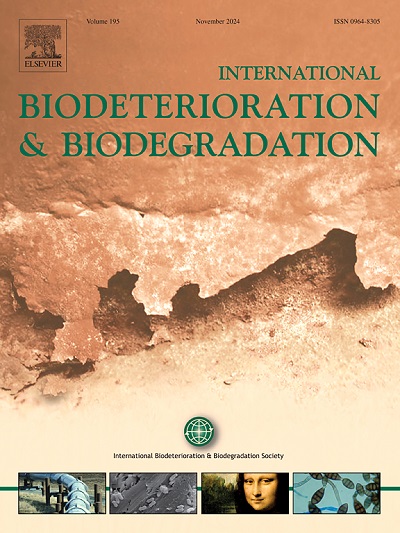Analysis of benzene, toluene, ethylbenzene, xylene(s) biodegradation under anoxic conditions using response surface methodology
IF 4.1
2区 环境科学与生态学
Q2 BIOTECHNOLOGY & APPLIED MICROBIOLOGY
International Biodeterioration & Biodegradation
Pub Date : 2025-02-01
DOI:10.1016/j.ibiod.2024.105973
引用次数: 0
Abstract
The biodegradation potential and metabolism of bacteria depend on the terminal electron acceptors present at contaminated sites. Due to the quick consumption of oxygen, microorganisms tend to use substitute electron acceptors such as nitrate, sulfate, manganese, and iron for biodegradation. The present study aims to investigate the effect of electron acceptors (nitrate, sulfate, and ferric ions) on BTEX biodegradation using Bacillus infantis (B. infantis) and Microbacterium esteraromaticum (M. esteraromaticum). The experiment was designed with response surface methodology using the Box-Behnken method. All four compounds of BTEX biodegraded with removal efficiencies ranging from 46% to 57% in Bacillus-treated samples, while 88–98% biodegradation in Microbacterium-treated cultures. The optimal growth of B. infantis was observed at 250 mg/L of nitrate and iron, while no effect of sulfate was observed. For M. esteraromaticum, 250 mg/L of nitrate and sulfate showed the maximum growth of more than 1 optical density (OD), however, no change in growth was noticed with iron treatment. The investigation showed a maximum BTEX biodegradation of 57% by B. infantis under sulfate reduction and overall, 98% by M. esteraromaticum in combined nitrate and sulfate reduction. The present work provides new insights into soil microbial community responses to electron acceptors under anoxic conditions, signifying that intrinsic microorganisms could be successfully stimulated for ISB with electron acceptors as a supplement.

求助全文
约1分钟内获得全文
求助全文
来源期刊
CiteScore
9.60
自引率
10.40%
发文量
107
审稿时长
21 days
期刊介绍:
International Biodeterioration and Biodegradation publishes original research papers and reviews on the biological causes of deterioration or degradation.

 求助内容:
求助内容: 应助结果提醒方式:
应助结果提醒方式:


